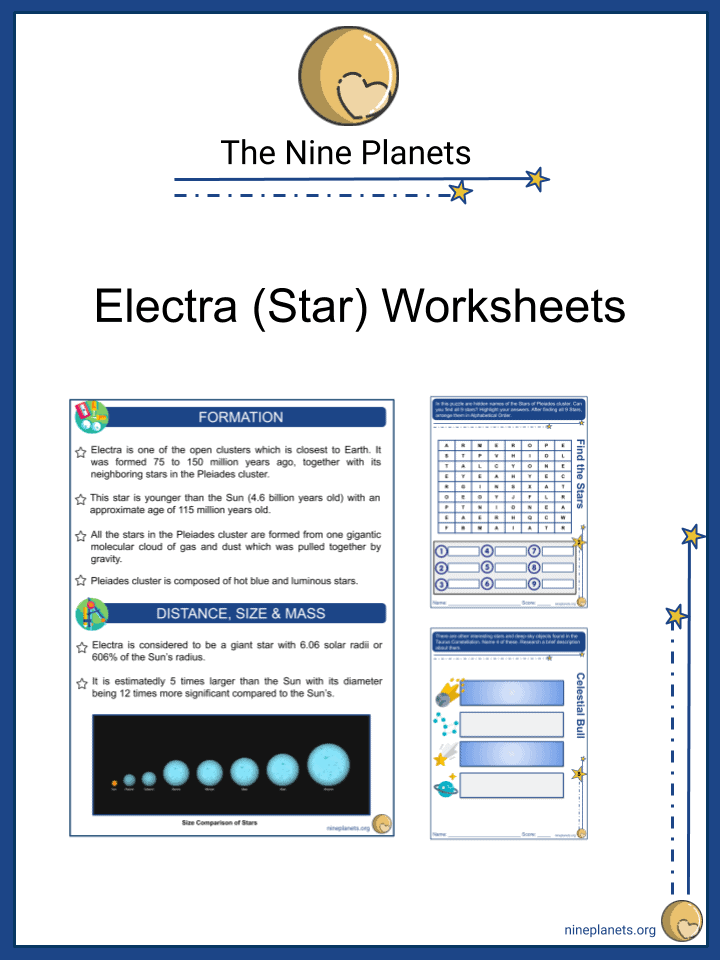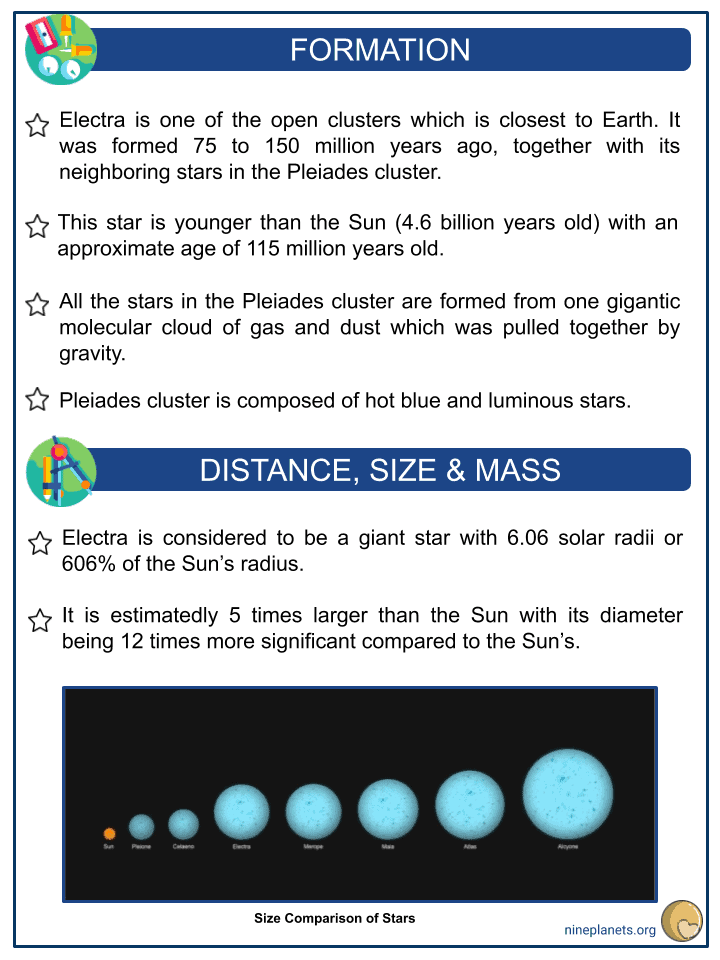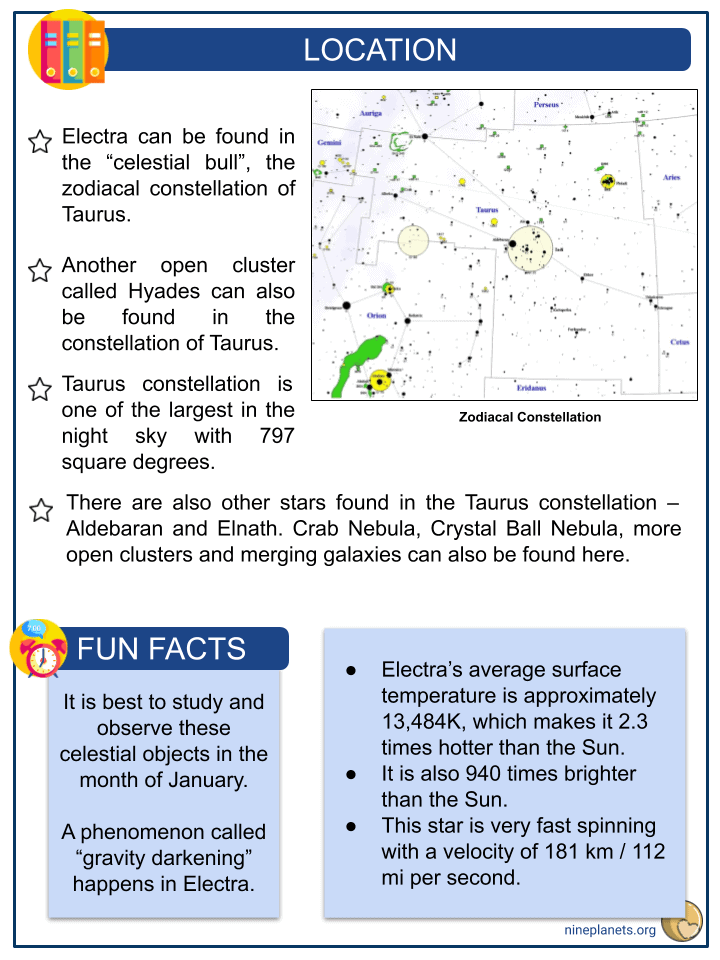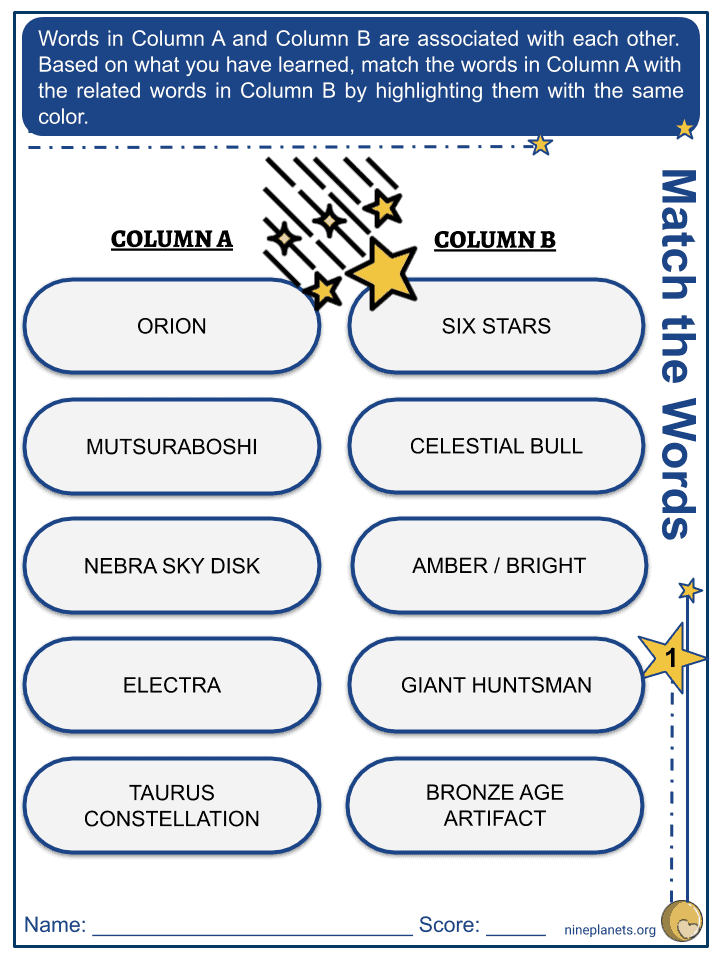Download Electra (Star) Worksheet
Click the button below to get instant access to these premium worksheets for use in the classroom or at a home.

This worksheet can be edited by Premium members using the free Google Slides online software. Click the Edit button above to get started.
Download free sample
Not ready to purchase a subscription yet? Click here to download a FREE sample of this worksheet pack.
Resource Examples
Click any of the example images below to view a larger version.




Key Facts & Information
- Electra is known as the third-brightest star in the open cluster of Pleiades. This star is 400 light-years away from the Sun.
- It is a blue-white giant star also called ”17 Tauri”, which is located in the celestial bull, the zodiacal constellation of Taurus.
- “Electra” is from Greek mythology. She is one of the seven daughters of Titan Atlas and Pleione, an Oceanid nymph. The other daughters of Atlas and Pleione are named as stars in the Pleiades cluster.
- She was the mother of Iason and Dardanus – the brothers who founded the city of Troy. Electra was the wife of Corythus, an Italian King to whom she bore Iason, while Dardanus is her son with Zeus.
- Some say, she disappeared in grief after the city of Troy was destroyed during the Trojan War, and is considered as the lost Pleiad.
- Electra is also the Greek word for “amber” and “bright”.
Formation
- Electra is one of the open clusters which is closest to Earth. It was formed 75 to 150 million years ago, together with its neighboring stars in the Pleiades cluster.
- This star is younger than the Sun (4.6 billion years old) with an approximate age of 115 million years old.
- All the stars in the Pleiades cluster are formed from one gigantic molecular cloud of gas and dust which was pulled together by gravity.
- Pleiades cluster is composed of hot blue and luminous stars.
Distance, Size & Mass
- Electra is considered to be a giant star with 6.06 solar radii or 606% of the Sun’s radius.
- It is estimatedly 5 times larger than the Sun with its diameter being 12 times more significant compared to the Sun’s.
Location
- Electra can be found in the “celestial bull”, the zodiacal constellation of Taurus.
- Another open cluster called Hyades can also be found in the constellation of Taurus.
- Taurus constellation is one of the largest in the night sky with 797 square degrees.
- There are also other stars found in the Taurus constellation – Aldebaran and Elnath. Crab Nebula, Crystal Ball Nebula, more open clusters and merging galaxies can also be found here.
Fun Facts
- It is best to study and observe these celestial objects in the month of January.
- A phenomenon called “gravity darkening” happens in Electra.
- Electra’s average surface temperature is approximately 13,484K, which makes it 2.3 times hotter than the Sun.
- It is also 940 times brighter than the Sun.
- This star is very fast spinning with a velocity of 181 km / 112 mi per second.
Pleiades Member
- The Pleiades cluster is one of the star clusters closest to Earth and also one of the brightest.
- This cluster is also called Messier 45, and includes spectral class B stars.
- One way to find this cluster is to draw a line from the Orion’s belt (Alnitak, Alnilam, and Mintaka), after Aldebaran, and you’ll be able to find this cluster.
- This cluster is composed of 9 stars namely, Alcyone, Asterope, Atlas, Electra, Celaeno, Maia, Merope, Taygeta, and Pleione.
- In mythology, the Seven Sisters were being pursued by Orion, a giant huntsman, but were saved by Zeus by turning them into doves, then later on, into stars.
The Future
- This cluster will survive for 250 million years, but because of gravitational interaction with its neighboring stars, it will soon disperse.
Did You Know?
- A Bronze Age artifact (1,6000 BCE) found in Germany is one of the earliest depictions of Pleiades cluster and its stars. This artifact is called the Nebra Sky Disk.
- In 1610, Galileo Galilei may have been the first person to conduct a telescopic observation on this cluster.
- In China, the Pleiades cluster is known as the Hairy Head, and Electra as the First Star of the Hairy Head, one of the seven mansions of the White Tiger.
- USS Electra (1843) and USS Electra (AK-21/AKA-4), both US Navy Ships, were named after this star.
- It is said that the Pleiades cluster may have been formed from the compact arrangement which seems to resemble Orion Nebula.
- There are a number of textbooks, famous and ancient, that mentioned the Pleiades cluster. Some of which are: Homer’s Iliad and Odyssey, Hesiod’s Work and Days, Bible, Egyptian Calendar of Lucky and Unlucky days, and Japanese Kojiki.
- In the Japanese Kojiki, the Pleiades cluster is known as the Mutsuraboshi which means “six stars”, while it is known as Subaru in modern Japan, the same name and meaning as the automotive company.